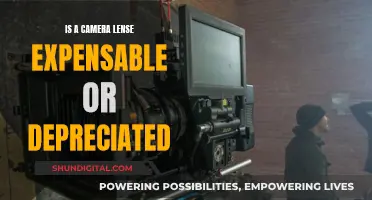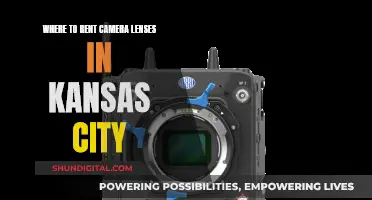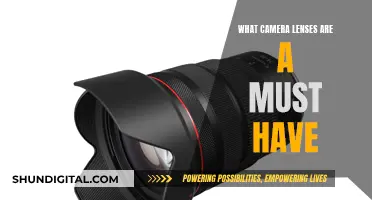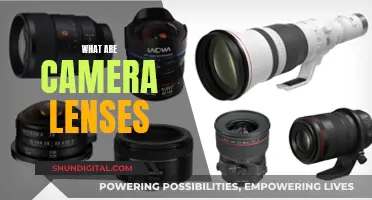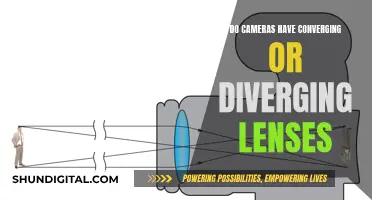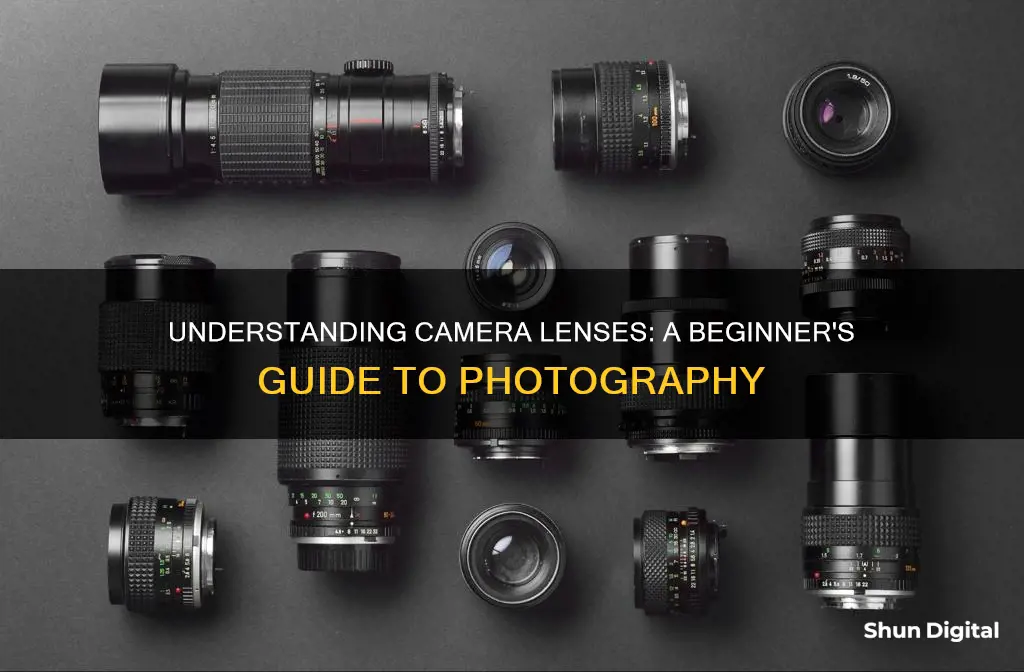
Camera lenses are an essential piece of equipment for photographers, arguably more important than the camera itself. The lens is what focuses light from what you see through the viewfinder into a tiny spot on the back of your camera, and without it, the only kind of image you can produce is white light. The lens you choose will depend on your specific needs and there are many factors to consider, including cost, size, weight, lens speed, and image quality.
What You'll Learn

Focal length
The longer the focal length, the narrower the angle of view and the higher the magnification. This means that the subject will appear smaller in the frame, but you will be able to capture a close-up of a distant subject. Telephoto and super-telephoto lenses fall into this category, with focal lengths starting at around 85mm.
Conversely, the shorter the focal length, the wider the angle of view and the lower the magnification. This means that you will be able to capture more of your subject in a photograph. Wide-angle lenses fall into this category, with focal lengths up to around 35mm.
Lenses with a single focal length are known as prime lenses, while those with variable focal lengths are called zoom lenses. Zoom lenses are more versatile and convenient as you can carry just one lens for a range of shooting situations. However, prime lenses tend to be more compact and lightweight, and they often have larger maximum apertures, which is an advantage when shooting in low-light conditions.
The focal length of a lens also depends on the camera's sensor size. Smaller sensors will crop the image, making the subject appear larger in the frame. This is known as the crop factor or focal length multiplier.
Minolta Lenses: Universal Fit for Minolta Cameras?
You may want to see also

Aperture
F-Stop Numbers
The F-stop number (or focal-stop number) is a reference to how open or closed the aperture is. The most common F-stop values are:
- F/1.4
- F/2
- F/2.8
- F/4
- F/5.6
- F/8
- F/11
- F/16
- F/22
The maximum and minimum aperture number, or F-stop value, varies from lens to lens. Increasing the F-stop number corresponds to closing the aperture, while decreasing it opens the aperture.
Large and Small Apertures
A large aperture is a wide opening of the lens, which allows more light to pass through. This is also called low ranging, with F-stop values usually ranging from f/1.4 to f/4. When the aperture is at its largest, it is referred to as "wide open".
A small aperture is the opposite: a narrow opening of the lens blades that doesn't allow much light to pass through. This is also called a high aperture, with F-stop values ranging from f/16 to f/22. When the aperture is at its smallest, it is referred to as "stopped down".
The depth of field is the proportion of the image that is reasonably sharp and in focus. The larger the aperture, the shallower the depth of field; more areas of the image will be out of focus. Conversely, a smaller aperture will result in a greater depth of field, with a bigger proportion of the image in focus.
The aperture and depth of field you use will depend on the scene you are photographing and the type of image you want to capture. For instance, landscape photographers typically aim to have as much of the image in focus as possible, while portrait photographers may want a blurred background so that all the attention is on the subject.
Using extreme aperture values is not recommended, as it can lead to a loss of sharpness in your images. When the aperture is very large, the diaphragm is wide open and trying to capture as much light as possible, which can result in softer results. When the aperture is very small, an optical effect called diffraction occurs, which results in poorer image quality.
The sharpest aperture varies depending on the lens model, but it is usually found two to three F-stop values from the maximum aperture. For example, if the maximum aperture is f/4, the sharpest aperture will likely be between f/8 and f/11.
The Ultimate Camera Lenses for Professional Photography
You may want to see also

Prime vs. zoom lenses
A prime lens has a fixed focal length, meaning it has a set angle of view that cannot be changed. The only way to change the angle is by physically moving closer or further away from your subject. Prime lenses have a single focal length, like 50mm, and come in all kinds of sizes, from fisheye to super-telephoto.
A zoom lens, on the other hand, has a variable focal length. This means you can change the angle of view by turning the zoom ring, making your subject appear larger or smaller. Zoom lenses have two focal length specifications, like 70-200mm, and may also have variable aperture ranges.
Advantages of Prime Lenses
- Prime lenses are often significantly cheaper than zoom lenses.
- They are usually smaller and lighter, making them more portable and convenient.
- Prime lenses offer more control over depth of field and can achieve a shallower depth of field, resulting in beautiful "bokeh".
- They are often sharper, especially at longer focal lengths, and tend to be sharper at their maximum aperture in the corners of the frame.
- Prime lenses typically have larger maximum apertures, such as f/1.8, which lets in more light and is ideal for low-light photography.
Advantages of Zoom Lenses
- Zoom lenses offer versatility, allowing you to quickly change from wide-angle to telephoto without having to move. This is especially useful for landscape and wildlife photographers who may be limited to a particular spot.
- They often have image stabilisation systems, allowing you to capture sharp images in low-light conditions, even with moving subjects.
- A single zoom lens can replace two or three prime lenses, reducing the weight of your gear and the need to constantly switch lenses.
The choice between a prime and a zoom lens depends on your specific needs and preferences. If you want very shallow depth of field and beautiful bokeh, a prime lens is ideal. If you need versatility, such as when travelling or shooting weddings, a zoom lens is a better option. It's worth noting that most wedding photographers use zoom lenses like the 24-70mm f/2.8, as it can do everything from group shots to portraits.
Clean Your Phone Camera Lens Scratch-Free
You may want to see also

Lens diameter
The lens diameter is the physical measurement of the diameter of the front-most part of the lens. It is different from the focal length and aperture. The lens diameter is usually threaded to allow filters and lens hoods to screw in.
The lens diameter is often marked on the lens using the symbol "ø" followed by a number (e.g. ø52 for 52mm). If it's not marked, you can measure the widest part of the lens or refer to the lens specifications. There is no set standard for lens diameter size, but there are some common sizes for the diameter of DSLR lenses: 43mm, 49mm, 52mm, 58mm, 62mm, 68mm, 72mm, and 77mm.
The lens diameter is needed when buying filters, lens caps, or hoods. The larger the lens diameter, the more light that can enter, and the larger the lens elements that can be used internally. This can potentially contribute to better optical quality, with less light fall-off at the edges (vignetting) and potentially sharper images at wide apertures.
Wide-angle and long telephoto lenses tend to have larger lens diameters to allow a wider perspective of the scene and to let in more light. Lenses designed for full-frame cameras also tend to have larger lens diameters than those designed for cropped-sensor bodies.
Vintage Camera Lenses: Worth the Money or Not?
You may want to see also

Lens features
The lens is the most important piece of equipment for a photographer. A high-quality lens can help capture great photos even with a cheap camera, while a low-quality lens can make the best camera mediocre. Here are some of the key features to look out for when choosing a lens:
Focal Length
Focal length refers to the zoom range or level of a lens and is measured in millimetres (mm). Lenses with a longer focal length, such as a telephoto lens, allow you to get closer to your subject and are often used for wildlife or sports photography. Wide-angle lenses, on the other hand, have shorter focal lengths, making them ideal for landscape or architecture photography.
Maximum Aperture
The aperture of a lens refers to the opening within the lens that allows light to pass through. Lenses with larger apertures, such as f/2.8, let in more light and produce a shallow depth of field, resulting in a blurred background. Smaller apertures, such as f/16, produce a larger depth of field with more sharp detail throughout the image.
Prime vs. Zoom Lenses
Prime lenses have a fixed focal length, while zoom lenses offer a range of focal lengths. Prime lenses tend to have larger apertures, making them better suited for low-light conditions and creating blurred backgrounds. Zoom lenses are more versatile, but typically have smaller maximum apertures.
Focusing Speed
Some lenses have faster autofocus capabilities than others. This feature is particularly important for sports, action, or event photographers who need to capture fast-moving subjects.
Weather Sealing
Weather sealing or weather resistance is an important feature for photographers who plan to shoot in harsh or unpredictable conditions. It allows you to use your camera and lens in rain, snow, or dusty environments without worrying about damage.
Image Stabilisation
Image stabilisation is a feature found in some lenses that helps reduce blur caused by camera shake, especially when shooting at slower shutter speeds or with longer focal lengths. Different brands have different names for this feature, such as VR (Vibration Reduction) for Nikon and OSS (Optical SteadyShot) for Sony.
Size and Weight
The size and weight of a lens can be an important consideration, especially for travel photographers or those who need to carry their gear for extended periods. Smaller and lighter lenses can be more convenient and easier to handle.
Durability and Build Quality
The durability and build quality of a lens can vary. Metal lenses are often considered higher-end, but high-quality plastic lenses can also be durable and have the advantage of being lighter and more impact-resistant.
Lens Coatings
Lens coatings can help reduce flare and internal reflections, especially when shooting towards bright light sources like the sun. High-quality coatings can improve image contrast and reduce haze in backlit environments.
Minimum Focusing Distance
Lenses have varying minimum focusing distances, which is the closest distance you can be to your subject while still achieving focus. Macro lenses are specifically designed for close-up photography, allowing you to focus on very small objects like insects or flowers.
Brand-Specific Features
Different lens brands may have unique features or technologies that set them apart. For example, Canon's "L" designation indicates a high-end lens, while Nikon uses a gold "ring" around the lens perimeter to denote pro-grade lenses.
CCD Camera Lenses: Color Corrected or Not?
You may want to see also
Frequently asked questions
A zoom lens allows the photographer to vary the focal length within a pre-defined range, whereas a prime lens has a fixed focal length. Zoom lenses are more flexible and are often critical for dynamic subjects, such as in photojournalism and children's photography. Prime lenses are typically more cost-effective, lighter, and have a larger maximum aperture, which is useful for low-light photography.
The focal length of a lens determines its angle of view and the magnification of the subject. Lenses with shorter focal lengths are wide-angle lenses, while those with longer focal lengths are telephoto lenses. The focal length also influences the perspective of an image and the ease of achieving a sharp handheld photograph.
The aperture of a lens refers to the opening that lets light into the camera. It is measured in f-numbers or f-stops, with lower numbers indicating a wider opening and more light entering the lens. Aperture settings affect the depth of field, exposure options, and the amount of light-gathering area.
The diameter of a camera lens, often referred to as the filter size, is the physical measurement of the front-most part of the lens. It is usually marked with the symbol "ø" followed by a number indicating the diameter in millimetres. If it's not marked, you can measure the widest part of the lens or refer to the lens specifications. Common DSLR lens diameters include 52mm, 58mm, 72mm, and 77mm.


